No ERC – Отключить проверку электрических правил
This document is no longer available beyond version 21. Information can now be found here: No ERC for version 24
Parent page: Schematic Objects
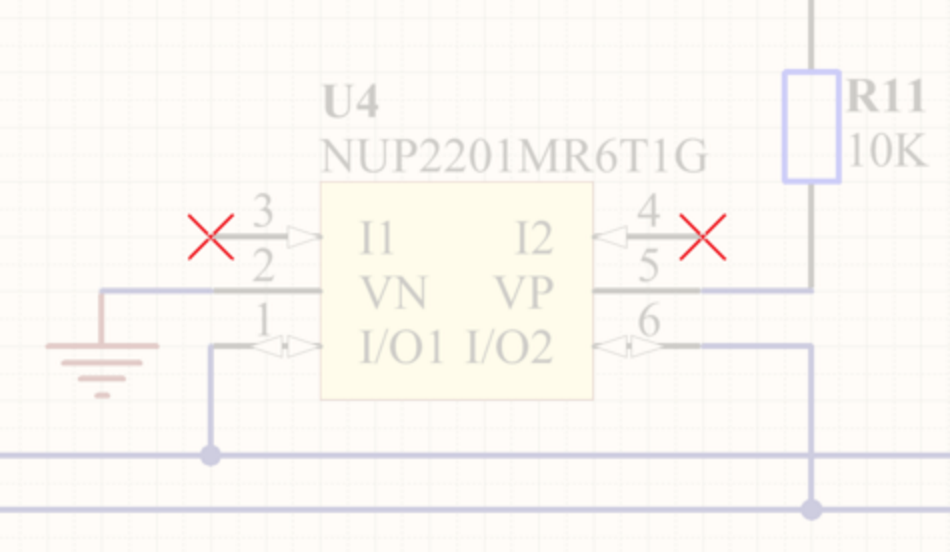 Use No ERC markers to suppress error/warning messages about a specific node in the circuit.
Use No ERC markers to suppress error/warning messages about a specific node in the circuit.
Summary
The No ERC object is a design directive. It is placed on a node in the circuit to suppress all reported Electrical Rule Check warnings and/or error violation conditions that are detected when the schematic project is compiled. Use No ERC to deliberately limit error checking at a certain point in the circuit that you know will generate a warning (such as an unconnected pin) while still performing a comprehensive check of the rest of the circuit.
The No ERC directive supports a number of different styles and can be displayed in any color. Use this ability to reflect the design intent for this point in the circuit.
 Choose a No ERC style that best reflects its function at that point in the circuit.
Choose a No ERC style that best reflects its function at that point in the circuit.
The No ERC directive has two types:
- All Violations – all possible warnings and/or error conditions are suppressed.
- Specific Violations – only the selected warnings or error conditions are suppressed; any other warnings or errors will be detected and reported.
Availability
No ERC design directives are available for placement in the Schematic Editor only. To place a No ERC directive:
- Click Place » Directives » Generic No ERC from the main menus or click
 on the Wiring toolbar to place a No ERC marker that is pre-configured to target all violations. This is sometimes referred to as a Generic No ERC directive.
on the Wiring toolbar to place a No ERC marker that is pre-configured to target all violations. This is sometimes referred to as a Generic No ERC directive. - Right-click in the schematic editor then click Place » Directives » Generic No ERC.
Placement - Generic No ERC Directive
After launching the command, the cursor will change to a cross-hair and you will enter placement mode. Perform the following to place the No ERC directive:
- Position the cursor over a wire or other net object then click Enter to place a directive at that point in the circuit.
- Continue placing further No ERC directives or right-click or press Esc to exit placement mode.
Additional actions that can be performed during placement are:
- Press the Tab key to pause the placement and access the No ERC mode of the Properties panel, from where its properties can be changed on-the-fly. Click the workspace pause button overlay (
 ) to resume placement.
) to resume placement.
Graphical Editing
The No ERC marker cannot be modified graphically other than changing its location. To move a No ERC marker, click and hold while dragging it to a new location.
Non-Graphical Editing
The following methods of non-graphical editing are available.
Editing via the No ERC Dialog or Properties Panel
Panel page: No ERC Properties
This method of editing uses the associated No ERC dialog and the Properties panel mode to modify the properties of an object.
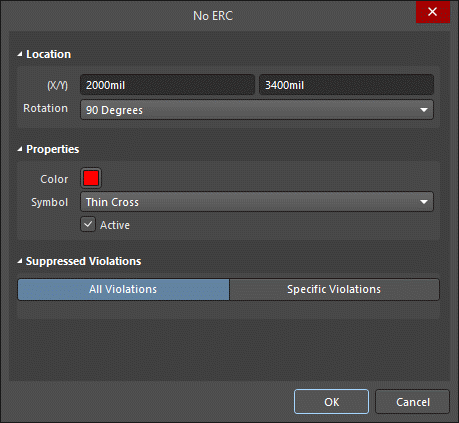
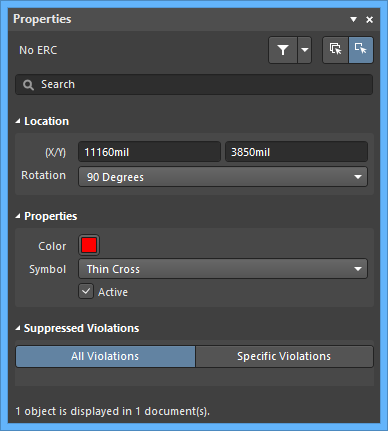 The No ERC dialog (first image) and the No ERC mode of the Properties panel (second image)
The No ERC dialog (first image) and the No ERC mode of the Properties panel (second image)
After placement, the No ERC dialog can be accessed by:
- Double-clicking on the placed No ERC object.
- Placing the cursor over the No ERC object, right-clicking then choosing Properties from the context menu.
During placement, the No ERC mode of the Properties panel can be accessed by pressing the Tab key. Once the No ERC is placed, all options appear.
After placement, the No ERC mode of the Properties panel can be accessed in one of the following ways:
- If the Properties panel is already active, by selecting the No ERC object.
- After selecting the No ERC object, select the Properties panel from the Panels button in the bottom right section of the workspace, or by select View » Panels » Properties from the main menu.
Editing via an Associated Properties Dialog
This method of editing uses the No ERC dialog to modify the violation types and connection errors of a Specific No ERC object.
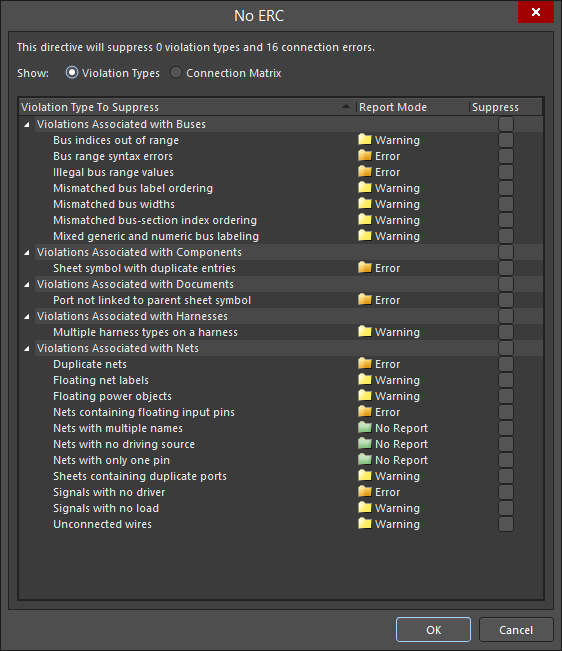
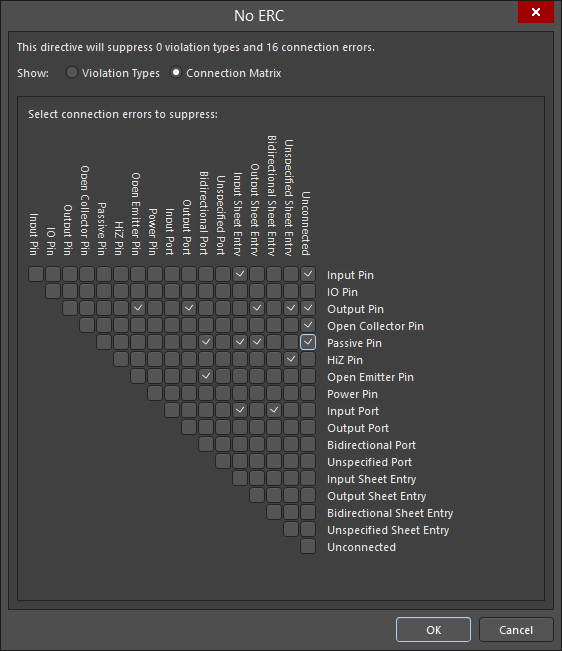 The No Erc dialog showing Violation Types mode (first image) and Connection Matrix mode (second image)
The No Erc dialog showing Violation Types mode (first image) and Connection Matrix mode (second image)
The dialog can be accessed by clicking Specific Violations in the Suppressed Violations region of the No ERC dialog and the Properties panel in No ERC mode.
Editing Multiple Objects
The Properties panel supports multiple object editing, where the property settings that are identical in all currently selected objects may be modified. When multiples of the same object type are selected manually, via the Find Similar Objects dialog or through a SCH Filter or SCH List panel, a Properties panel field entry that is not shown as an asterisk (*) may be edited for all selected objects.
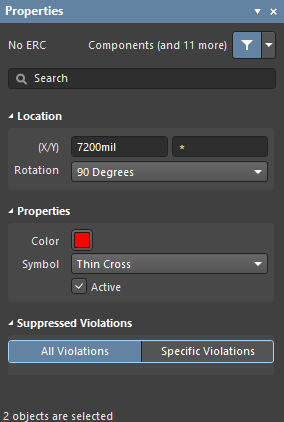
Editing via a List Panel
Panel pages: SCH List, SCH Filter
A List panel allows you to display design objects from one or more documents in tabular format, enabling quick inspection and modification of object attributes. Used in conjunction with appropriate filtering - by using the applicable Filter panel or the Find Similar Objects dialog - it enables the display of just those objects falling under the scope of the active filter – allowing you to target and edit multiple design objects with greater accuracy and efficiency.
Controlling the Printing of No ERC Directives
By default, No ERC markers are included during printing. To control this by either disabling their inclusion entirely or excluding only specific symbols, use the Schematic Print Properties dialog as shown below.
 Control the printing of No ERC markers in the Schematic Print Properties dialog.
Control the printing of No ERC markers in the Schematic Print Properties dialog.
This dialog can be accessed by:
- Click File » Page Setup then click Advanced.
- On the Default Prints tab on the Project Options - Default Prints dialog, select Schematic Prints in the list then click Configure.
- Click File » Print Preview then right-click in the Preview Schematic Prints dialog and choose Configuration.
